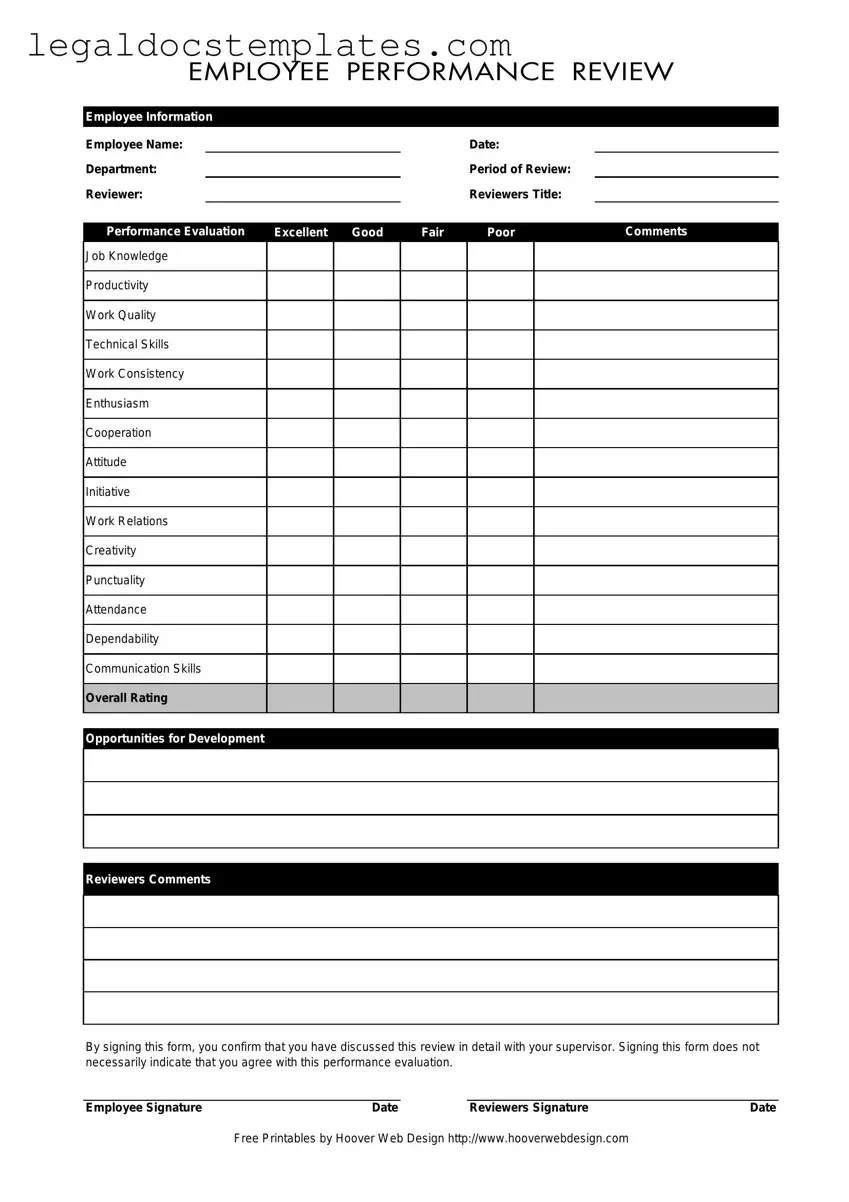The Employee Information section requires several key pieces of information, including the Employee's Name, the Date, Department, Period of Review, Reviewer, and the Reviewer's Title. This information sets the foundation for identifying the employee under review and the context of the evaluation.
The performance evaluation is structured around various competencies, including Job Knowledge, Productivity, Work Quality, among others. Each competency is assessed on a 4-point scale: Excellent, Good, Fair, and Poor. Reviewers are also encouraged to provide specific comments for each competency to furnish more detailed feedback.
This form assesses an employee on multiple fronts:
-
Job Knowledge
-
Productivity
-
Work Quality
-
Technical Skills
-
Work Consistency
-
Enthusiasm
-
Cooperation
-
Attitude
-
Initiative
-
Work Relations
-
Creativity
-
Punctuality
-
Attendance
-
Dependability
-
Communication Skills
-
Overall Rating
Each area provides an insight into different aspects of an employee's performance and behavior at work.
Yes, signing the form is crucial as it confirms that both parties, the employee and the reviewer, have engaged in a detailed discussion about the review. However, it's important to note that signing the form does not necessarily imply agreement with the performance evaluation. It merely acknowledges that the review has taken place.
What happens if an employee disagrees with the evaluation?
If an employee disagrees with the evaluation, it's recommended that they discuss their concerns directly with the reviewer to seek clarification or adjustments. Signing the form stipulates acknowledgement of the discussion, not necessarily agreement with its contents. Employees are encouraged to document their concerns and, if necessary, follow up with Human Resources for further resolution.
Performance evaluations can significantly influence career progression within a company. They provide formal records of an employee's strengths and areas for improvement, which can inform decisions regarding promotions, salary adjustments, and professional development opportunities. Therefore, engaging constructively with the review process is in the best interest of both employees and their career aspirations.
How often are these evaluations conducted?
The frequency of evaluations depends on the company's policy; however, it is common practice to conduct them annually. Some organizations may choose to perform evaluations more frequently, such as semi-annually or quarterly, to ensure continuous performance monitoring and development.
These sections are designed for the reviewer to provide additional feedback beyond the structured competency ratings. "Opportunities for Development" offers suggestions for professional growth, identifying areas where the employee can enhance their skills and contributions. "Reviewer's Comments" allows for more comprehensive feedback, including achievements, challenges, and future goals. These narrative sections play a critical role in guiding the employee’s professional development.
While specifics can vary by organization, the following guidelines are generally recommended for completing the ratings and comments sections:
-
Be clear and concise; avoid ambiguous language.
-
Provide specific examples to support ratings, especially for areas marked as needing improvement.
-
Focus on behavior and outcomes rather than personal traits.
-
Maintain objectivity, basing the evaluation on observed performance and outcomes.
-
Encourage ongoing dialogue, offering constructive feedback and recognizing achievements.
These guidelines help ensure that evaluations are fair, comprehensive, and useful for employee development.

